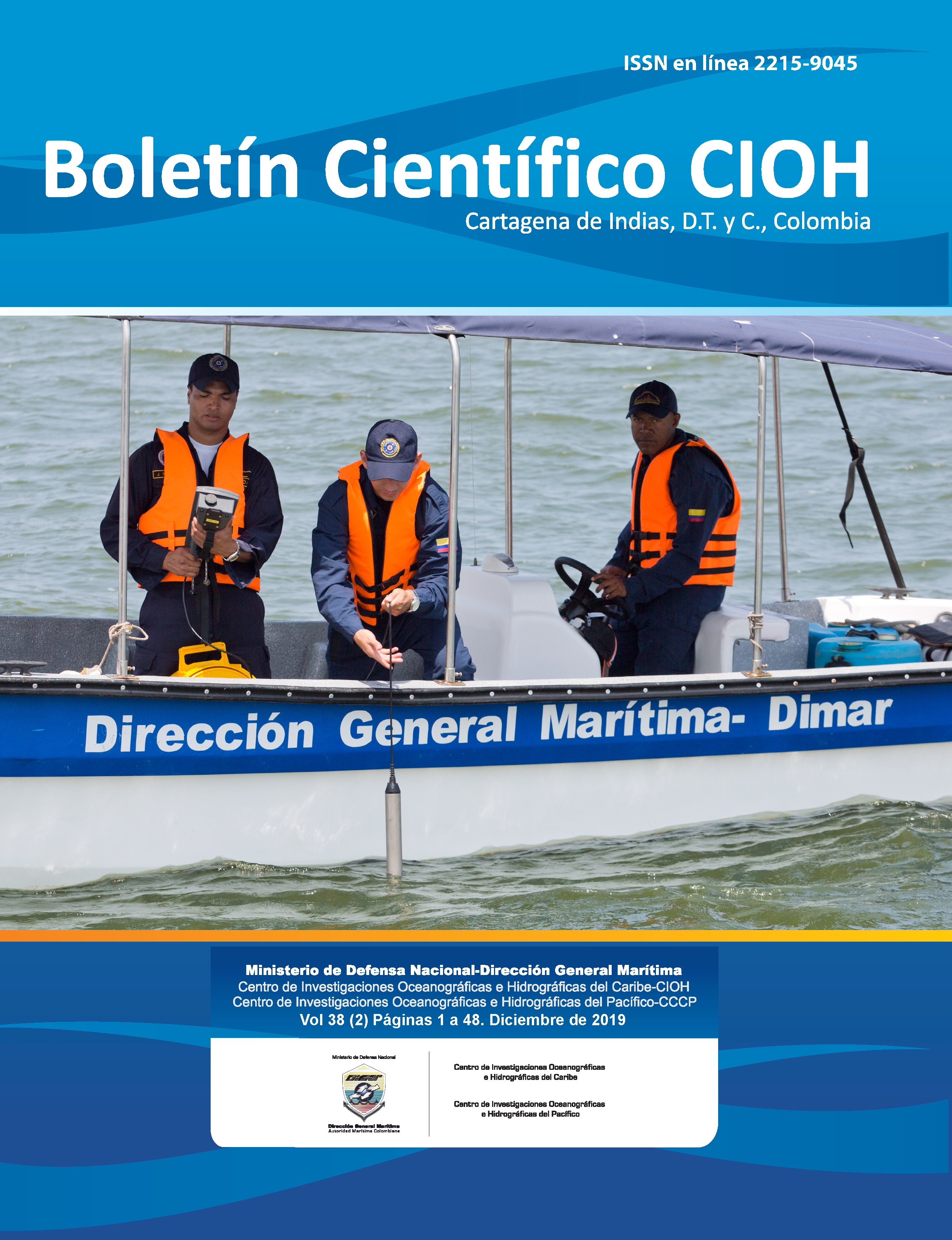PHYSICAL VULNERABILITY IN BUILDINGS IN THE SECTOR OF BOCAGRANDE, CARTAGENA DE INDIAS; AT A TSUNAMI EVENT
DOI:
https://doi.org/10.26640/22159045.2019.508Keywords:
vulnerabilidad física, sistemas de información geográfica, tsunamisAbstract
Tsunamis are among the most devastating and uncommon natural phenomena, it is the result of an underwater disturbance that breaks into the coastal zone. However, scientific research in the Caribbean Sea regarding these events is minor due to its unusual occurrence if compared to the Pacific Ocean. The physical vulnerability of 305 buildings was evaluated at Bocagrande; a notable area at the socioeconomic and tourist level; implementing the Papathoma Tsunami Vulnerability Assessment (PTVA4) model which has been analyzed and validated obtaining satisfactory results. Likewise, the relevant information was collected through the mobile application survey 123 for ArcGIS, representing the results on thematic maps based on Geographic Information Systems. The relative vulnerability index of each building could be determined, providing a tool for future decision making and implementation by local authorities.Downloads
References
Carvajalino, L. (2018). Cien años después, ¿está preparado el Caribe para otro gran tsunami? Retrieved from NOTICIAS UNINORTE
Dall’Osso, F., Dominey-Howes, D., Tarbotton, C., Summerhayes, S., & Withycombe, G. (2016). Revision and improvement of the PTVA-3 model for assessing tsunami building vulnerability using “international expert judgment”: introducing the PTVA-4 model. Natural Hazards, 83(2), 1229-1256.
Estrada, B., & Farbiarz, J. (2005). El terremoto y posterior tsunami del 26 de diciembre de 2004 en Indonesia. Dyna, 72(145), 85–90.
Fernández A., M. (2002). Daños, efectos y amenaza de tsunamis en América Central. Revista Geológica de América Central, 26(26), 71–83.
Fuentes, D., Mercado, M., & Quejada, R. (2012). Diagnóstico socioeconómico y del mercado de trabajo. Cartagena de Indias.
Intergovernmental Oceanographic Commission. (2019). Tsunami Glossary.
INVEMAR & ANH. (2010). Biodiversidad del Margen Continental del Caribe Colombiano. Serie de Publicaciones Especies
Izquierdo, T., Fritis, E., & Abad, M. (2018). Analysis and validation of the PTVA tsunami building vulnerability model using the 2015 Chile post-tsunami damage data in Coquimbo and La Serena cities.
Koshimura, S., Hayashi, S., & Gokon, H. (2014). The impact of the 2011 Tohoku earthquake tsunami disaster and implications to the reconstruction. Soils and Foundations, 54(4), 560-572.
Lader, J. F., Whiteside, L. S., & Lockridge, P. A. (2002). A brief history of tsunamis in the Caribbean SEa. Science of Tsunami Hazards, 20(2), 57–94.
Leslie, S. C., & Mann, P. (2016). Giant submarine landslides on the Colombian margin and tsunami risk in the Caribbean Sea. Earth and Planetary Science Letters, 449, 382–394.
Masson, D. G., Harbitz, C. B., Wynn, R. B., Pedersen, G., & Løvholt, F. (2006). Submarine landslides: Processes, triggers and hazard prediction. Philosophical Transactions of the Royal Society A: Mathematical, Physical and Engineering Sciences, 364(1845), 2009–2039.
National Centers for Environmental Information. (2017). Tsunami Sources 1610 B.C. to A.D. 2017 from Earthquakes, Volcanic Eruptions, Landslides, and Other Causes.
Omira, R., Baptista, M. A., Miranda, J. M., Toto, E., Catita, C., & Catalão, J. (2010). Tsunami vulnerability assessment of Casablanca-Morocco using numerical modelling and GIS tools. Natural Hazards, 54(1), 75–95.
Papathoma-Köhle, M., Keiler, M., Totschnig, R., & Glade, T. (2012). Improvement of vulnerability curves using data from extreme events: Debris flow event in South Tyrol. Natural Hazards, 64(3), 2083–2105.
Papathoma, M., Frontiers, R., & Dominey-Howes, D. (2003). Tsunami vulnerability assessment and its implications for coastal hazard analysis and disaster management planning, Gulf of Corinth, Greece. Natural Hazards and Earth System Science, 3(6), 733–747.
Tingsanchali, T., & Karim, M. F. (2005). Flood hazard and risk analysis in the southwest region of Bangladesh. Hydrological Processes: An International Journal, 19(10), 2055-2069.
UNGRD, U. N. para la G. del R. de D. (2018). Atlas de Riesgo de Colombia: revelando los desastres latentes. In Unidad Nacional para la Gestión del Riesgo de Desastres.
United nations, Bárcena, A., Prado, A., López, L., & Samaniego, J. (2010). The Chilean earthquake of 27 February 2010: an overview. In United Nations publication.
Downloads
Published
Issue
Section
License
Copyright (c) 2019 Boletín Científico CIOH

This work is licensed under a Creative Commons Attribution-NonCommercial-NoDerivatives 4.0 International License.
Attribution — You must give appropriate credit, provide a link to the license, and indicate if changes were made. You may do so in any reasonable manner, but not in any way that suggests the licensor endorses you or your use.
NonCommercial — You may not use the material for commercial purposes.
NoDerivatives — If you remix, transform, or build upon the material, you may not distribute the modified material.
No additional restrictions — You may not apply legal terms or technological measures that legally restrict others from doing anything the license permits.



